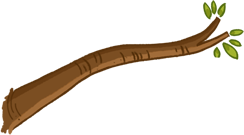Build a Rainforest Habitat
Use the Habitat Builder Tool to design your habitat.
 Habitat Builder Tool
Habitat Builder Tool

Now it is time to build your animal habitat.
First, click the animal you chose.
What does your animal need to live in its habitat? Click the food that your animal eats. You may choose more than one type of food.
How will your animal get water? Click the water source for your animal. You may choose more than one.
Where does your animal find shelter? Click the shelter for your animal.
Give your habitat the Survival Test! Check to make sure your habitat will provide everything that your animal needs to survive.
Click the
Test
button when you are ready.
Teacher's Note
In this activity, students will continue following the engineering design process and use this tool to create their virtual habitats. When each group is confident in the choices they made for planning their animal habitats in their Rainforest Detective Notebooks, work with them to create and submit their habitats using this tool. Students should use their Rainforest Detective Notebook as a guide, replicating the animal and resources they have already cut and pasted into their notebooks. If your class is sharing one computer, work with each group to complete a successful habitat before calling up the next group.
The first part of the Builder Tool asks students to identify their animal by clicking on it.
The second part of the tool asks students to choose pictures of items that their animal eats. If students need help, refer them to the choices they made in their notebooks on page 8.
The third part of the tool asks students to identify pictures of water sources.
The fourth part of the tool asks students to identify pictures of shelter for their animals.
The fifth part of the tool is a “Survival Test” and determines whether the students’ habitats were built with the appropriate items for their animals to live. Once students click “Test” on the Survival Test screen, they will receive immediate feedback. If students do not pass the Survival Test, they will be prompted to try again. Before students click the “Try Again” button, have them return to page 8 in their Rainforest Detective Notebooks to record the items that were correct and those that were incorrect in the tool. Students may place a check mark next to pictures of items that they chose correctly and place an X next to pictures of items that the tool marked wrong. Assist students as they transfer this information from the tool to their notebooks. After students have recorded this information, they should click the “Try Again” button and use the notebook as a reference when they make new choices. (Students will get three chances before they are presented with the correct habitat that shows proper choices for food, water and shelter.)
Be sure to discuss with students how well their habitat scored in the Survival Test, and encourage them to think of any problems with their habitats and possible modifications.
For students who do not complete the assignment successfully, remind them that in the engineering design process, it often takes several tries to come up with a successful design. Encourage them to think about what they have learned about habitats and what animals need to survive.
This activity helps to ensure that students understand what animals need to survive, how plants and animals in the rainforest are connected, and what a habitat is. Encouraging students to explain to their team members or partners why they made each choice in the Builder Tool will help to assess these essential questions.
Survival Test
Check toggle Water audioIs there water for the animal?
Check toggle Food audioDoes the habitat provide the right kind of food for the animal?
Check toggle Shelter audioIs there a place for the animal to find shelter?
Test
Try again.
You need:
Bird Bugs Eggs Flower Fruit Fungus Leaves Lizard Flower Fruit Leaf Pond Branches Dirt mound Leaves Nest Pond Hole in Tree
Look at your choices to see what is correct
 and what is incorrect
and what is incorrect
 .
.

Try again.
You need:
Bird Bugs Eggs Flower Fruit Fungus Leaves Lizard Flower Fruit Leaf Pond Branches Dirt mound Leaves Nest Pond Hole in Tree
Look at your choices to see what is correct
 and what is incorrect
and what is incorrect
 .
.
 Here are the correct choices for the Hummingbird.
Here are the correct choices for the Hummingbird.
 Here are the correct choices for the Tapir.
Here are the correct choices for the Tapir.
 Here are the correct choices for the Red-eyed tree frog.
Here are the correct choices for the Red-eyed tree frog.
 Here are the correct choices for the Toucan.
Here are the correct choices for the Toucan.
 Here are the correct choices for the Leafcutter ant.
Here are the correct choices for the Leafcutter ant.
 Here are the correct choices for the Capuchin monkey.
Print
Here are the correct choices for the Capuchin monkey.
Print



















































